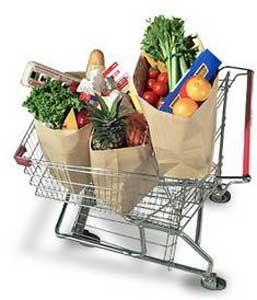 Pamela Ofstein is the Director of Nutrition Services at eDiets.com, a leading provider of weight loss services, information and products.
Pamela Ofstein is the Director of Nutrition Services at eDiets.com, a leading provider of weight loss services, information and products.
If you’re like me, any place I can save a few pennies (or dollars) helps. For most of us, this economy has put a squeeze on our spending; we’re stretching our dollars as much as we can.
When was the last time you went to the grocery store and your bill was less than expected? With less money coming in and costs rising, it’s tough to cut corners, especially when it comes to food and nutrition.
But despite those factors, there are ways to eat cheaper, healthier and save a few dollars here and there. It may take a little thinking out of the box, but the payoff can be worth it.
There are definitely some tricks when making that next trip to the grocery store. Follow these tips to help stretch out those dollars:
Plan Ahead with a List: Knowing what you need and making a list will assist you in purchasing only the items you need. Do a quick sweep of your pantry and refrigerator and see what items you have and need. You can get in there, pick out the items on your list and be done quickly, efficiently and without items you didn’t intend to purchase.
Make a Menu: Plan your meals or recipes prior to stepping foot in the grocery store. Think about items that can overlap for multiple meals. For instance, if a recipe calls for canned beans (it often doesn’t call for the entire can), think about other items it can be used in (soups, rice and beans, etc.). You waste less and you can make a few recipes out of it.
Look for Sales: What is on sale for the week? You can take advantage of coupons and focus on the food items that are cheaper (use chicken instead of beef if it cost less that week). Sometimes if a recipe calls for a certain vegetable (e.g. string beans), substituting it for another vegetable (broccoli) that might be on sale works out better for your wallet.
Go for the Season: Focus on the items (like vegetables and fruit) that are in season. Seasonal items are usually a lot cheaper and you get the freshest of what is out there in the market.
Try Canned and Frozen Foods: If fresh is cheaper, it’s usually the better option but buying canned or frozen can be a lot cheaper and easier. Many of them are just as nutritious (i.e. canned tomatoes) and less expensive, plus they last longer.
Consider Protein Alternatives: Often as I mentioned, I pick the items on sale. You can usually substitute some of the high-cost protein items for cheaper, same-quality ones (e.g. tuna for tilapia, etc.). Or try substituting a less expensive protein source like using beans, eggs or tofu. And pay attention to portion sizes: When it comes to fish, meat and poultry, you can save a lot of money by eating the recommended portion size.
Overlap Recipes: Casseroles or stews are easy dishes to make and you can use a variety of items – whatever you like (plus they freeze well). Roasting a chicken is an easy meal and using leftovers the next day makes another perfect meal – pair it with couscous and mixed vegetables the first night and brown rice and a salad the next (two meals, one protein source).
Never Go Hungry: Eat before you go. All of us fall victim to impulse buying when we are hungry. By having a quick snack prior to your visit, you can help curve that hunger and halt some of those items you just have to have.
See our eDiets review or Get more advice on losing weight and living better from the experts at eDiets.com.
___________________________________________________
Guest Blog Series: Look for the following badge on your favorite health sites to see if they have been a featured guest blogger on DietsInReview.com. See other posts in the Guest Blog series.
If you would like to apply to be featured as a guest blogger, please contact us.

